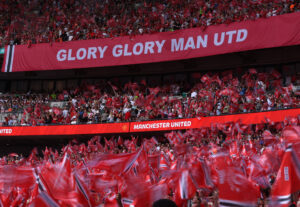There are two stand-out contenders for the title of Arsenal’s greatest midfielder ever; Patrick Vieira and Alex James, and they are different in almost every respect. They were opposites not just physically, as Vieira was a towering 6ft 4″ and James a diminutive 5ft 4½”, but also, as Arsène Wenger famously used to say, ‘footballistically’. That is because Vieira was a great all-round, box-to-box midfielder, while James was arguably not a midfielder at all but instead, to use the old-fashioned phrase, “an inside forward”, or, in modern football parlance, a number ten.
However, what Vieira and James have in common is that they were probably the two totemic figures of the two greatest periods in Arsenal’s history. Vieira was the greatest midfielder in Arsenal’s ‘Silver Age’, which lasted between 1986 (when George Graham was appointed as manager) and 2006 (when Wenger’s last great side lost the Champions League final to Barcelona). And James was the most important player and midfield lynchpin of what is undoubtedly Arsenal’s ‘Golden Age’, in the 1930s, when they dominated English football in a way that not even the great teams of Graham and Wenger could achieve more than half-a-century later. And it is that fact, namely that James was the greatest player in the greatest ever Arsenal team, that just gives him the edge over Vieira as Arsenal’s greatest ever midfield player.
Alex James: The Managers, Players and Matches That Made Arsenal
A Diminutive Scottish Genius
Alexander Wilson James, to give the little man his full name, was born in the small town of Mossend, in Lanarkshire, Scotland, in 1901, and the fact that he was Scottish was as pivotal to his career as he was to Herbert Chapman’s great Arsenal side of the 1930s. That was because it was Scottish footballers who introduced the first major tactical revolution in football history and the one that, more than a century on, remains arguably the most important tactical revolution in football history. That was the simple but profound change of passing the ball rather than simply running, or dribbling, with it, which had been the dominant tactic of English professional football in the first few decades of its history at the end of the 19th century.
Few players, if any, were to prove better at passing a football than Alex James. That was demonstrated conclusively at Wembley in the summer of 1928 when he became one of the ‘Wembley Wizards’, a wonderfully alliterative nickname that was not applied to the great Hungarian team of the 1950s, who famously defeated England 6-3 in 1953 and thus shattered any English illusions of footballing invincibility, but to a similarly magnificent (if much shorter-lived) side from a quarter-century earlier. That was the Scotland team that beat England, at home, 5-1, with James one of a fabulous forward line that more than made up in footballing ability what it lacked in physical prowess, especially height. Along with the likes of Hughie Gallacher and another great Alexander (Alex Jackson), James put England to the sword, famously claiming afterwards “we could have had ten”, and not even the most one-eyed England fan or reporter could have disagreed.
Alex James Had Finally Arrived
James’ spectacular performance at Wembley (he scored two of Scotland’s goals, while his near-namesake Jackson got the other three) really launched him into the footballing firmament, especially in England. He had already been a professional for six years, first with Raith Rovers in his native Scotland and then with Preston North End after moving to England. He had steadily built a reputation as a skilful attacking midfielder, at a time when the concept of ‘midfield’ did not really exist as such and teams were effectively starkly divided into defenders and forwards (or, as in James’s case, inside forwards). However, after that steady rise up the professional ranks, first in Scotland and then south of the border in England, James, like so many of his Scottish team-mates that day, finally arrived with the biggest of footballing bangs, even if he was already nearly 27-years-old.
What followed was one of the greatest last acts of any footballer’s career, not just at Arsenal but at any club anywhere, because James’ starring performance at Wembley in the summer of 1928 attracted the attention of many admirers, and most importantly of all, Herbert Chapman, the Arsenal manager who was yet to become the legendary Arsenal manager who transformed the club.
Herbert Chapman’s Greatest Signing
That was because in 1928, Chapman was yet to build on his extraordinary achievements at Huddersfield Town, who he had led to the first two of a hat-trick of league titles between 1923 and 1925 before leaving Yorkshire for London and the then utterly unsuccessful Arsenal. Having been formed in 1886, the Gunners had failed to win anything in their first 40 years of existence. Indeed, they were more famous for having decamped from south London (where the club had originally been founded as Woolwich Arsenal) to north London, thereby upsetting Tottenham Hotspur, the original occupants of that part of London, than they were for anything they had done on the pitch.
Chapman had been hired by Arsenal to change all that, but his success was anything but immediate. In his first three seasons in charge, Arsenal improved but still failed to win any silverware. Indeed, it appeared that Chapman might just have lost his supposed Midas touch when Arsenal lost the 1927 FA Cup final to Cardiff City, the one and only time in the history of England’s premier cup competition that the trophy has been won by a side from outside of England. However, after Alex James performed so brilliantly at Wembley with Scotland a year later, Chapman finally felt that he had found the man who could be his on-field leader, a midfield general before the term was even invented.
At a time when professional contracts were designed to favour clubs rather than players (a status quo that would only be broken by the Jimmy Hill-led footballers strike in the early 1960s that led to the ending of such restrictive contracts and the maximum wage), Chapman could not prise James away from the north of England instantly or easily. However, he remained patient and, a year later, in 1929, he finally secured his signing. Now, with Chapman in control off the field and James in control on it, Arsenal were finally ready to start winning trophies.
The Catalyst for Success
James’ success at Arsenal was both instant and enduring. Indeed, it was much more instant than that of Chapman himself and eventually also proved more enduring, as Chapman tragically died in January 1934, when Arsenal were almost exactly halfway through winning the hat-trick of titles that they won between 1933 and 1935. But long before that, James had proved to be the catalyst for success that Arsenal had hoped Chapman himself would be.
In his very first season with the club, James spearheaded Arsenal to their first-ever major silverware, as they won the FA Cup in 1930, defeating Chapman’s former club, Huddersfield, 2-0 in the final. However, that was just the beginning of a near-decade of success that would make Arsenal not only the most successful football team in England but the world’s first world-famous football club.
A year after winning their first-ever piece of silverware, Arsenal won their first-ever league title, and as he was to prove throughout the rest of the decade Alex James was absolutely instrumental. In the team of stars that Chapman had spent half a decade assembling, including such luminaries as James’ fellow inside-forward (or attacking midfielder) David Jack, winger-cum-striker Cliff Bastin (who remained Arsenal’s all-time record goal-scorer, on 178 goals, until first Ian Wright and then Thierry Henry surpassed him more than 60 years later) and later the great centre-forward Ted Drake, James was always the first among equals. He controlled the play, creating many of the goals that Jack, Bastin and Drake scored, and also became the visual emblem of the team, in the long, baggy shorts that he wore (which were baggy even for the time) in order to cover the thermal underwear that he wore to keep warm, leading his team-mates to question whether he really was Scottish as he seemed to feel the cold so much.
The Greatest Player in a Great Team
In total throughout the 1930s, James played over 250 games for Arsenal, scoring some 40-odd goals in league and cup matches but creating far more for the strikers in front of him. However, it was the silverware that he won that was his greatest and most lasting achievement. Before he finally retired in 1937, he won four league titles, including that hat-trick of titles between 1933 and 1935, and two FA Cups, after Arsenal won the cup again in 1936. That compares favourably with the three titles and four FA Cups that Patrick Vieira won in his nine seasons with Arsenal between 1996 and 2005, although Vieira can legitimately claim to have won the World Cup, after triumphing with France in 1998. By contrast, James, the proud Scot, was obviously not one of the seven Arsenal players in the England side that beat the reigning world champions Italy at Highbury in 1934, which has prompted many Arsenal fans ever since to claim that they are the only club side ever to win the World Cup.
After retiring as a player, Alex James continued to work in football, first as a coach in Poland (until World War Two broke out), then as a journalist and finally as an entrepreneur of sorts, running his own football pools competition, whereby fans placed bets by predicting the results of games. However, his own luck ran out when he was only 51 and, just like his great mentor Chapman, who had died suddenly of pneumonia (which he contracted while watching an Arsenal third-team game in the rain), James died suddenly of cancer.
Alex James Deserves a Statue
For nearly a decade and a half, ever since that fateful late defeat to Barcelona in the 2006 Champions League final, Arsenal have often been accused of being a club (and indeed a fan-base) that live in the past, erecting more statues to former players and managers – Wenger, Henry, Dennis Bergkamp and Tony Adams – at The Emirates than they have won trophies. Those were the three FA Cup wins in four seasons between 2014 and 2017 that would have delighted most clubs’ fans but barely appeased Gooners, who, given the club’s long history of success, rightly demand more. However, if there is ever to be one more statue added to the statuary at The Emirates, it should surely be one of Alex James, the Wembley Wizard who became Arsenal’s greatest ever midfielder, and the on-field leader of their greatest ever teams.
Main Photo






